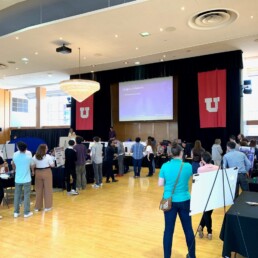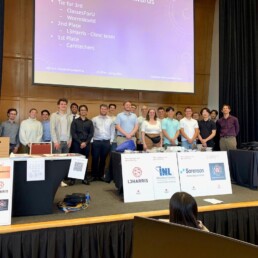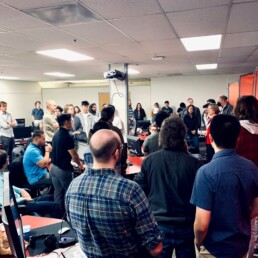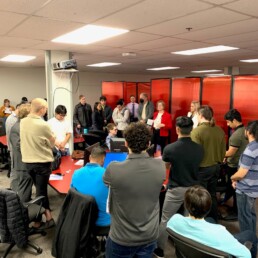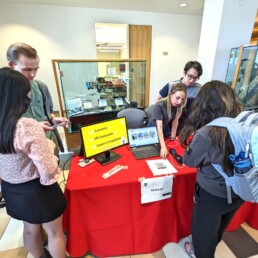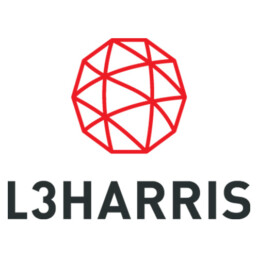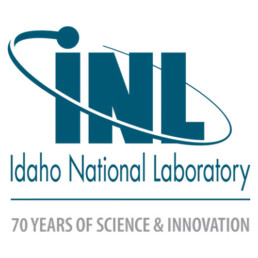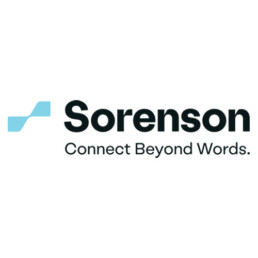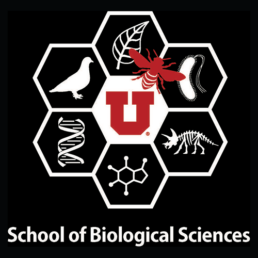Overview of the Kahlert School of Computing Clinical Capstone Project
The Clinical Capstone Program matches a team of motivated senior undergraduate computer science students with an industry sponsored project, defined and funded by an industry sponsor.
The team of students completes the final two semesters of their degrees working toward realizing the sponsor’s idea. Each team is advised by a School faculty member and works ~10 hours a week defining, researching, analyzing, and then producing a solution to meet the project’s objectives.
Ideal Clinical Capstone Project
The best projects have strong design elements that can help the students follow a rigorous process starting with creation of specifications, followed by creative concept generation and analysis, and culminating with a tested working prototype. Please propose your best idea, and we will work together to scope it correctly.
Timing
The two-semester Clinical Capstone Program is offered in two sequences:
- Fall and Spring semesters (August start)
- Spring and Fall semesters (January start)
At the end of each project, the teams participate in a Demo Day event, showcasing their work to faculty and industry judges, as well as fellow students.
Companies are encouraged to submit project proposals by August 1 for a Fall semester start, and December 1 for a Spring semester start. *We will meet with potential sponsors at any time, and sometimes late projects can be accepted.
How It Works
Faculty Advisor: Each team will have a faculty advisor guide them through the process with the industry sponsor.
Student Teams: Teams generally consist of 4 students.
Industry Sponsor Advisor: A representative from the industry sponsor is expected to serve as an advisor or co-advisor to help make sure the team stays on track to meet the project objectives. The industry sponsor advisor will typically spend an hour or less per week with the team – often meeting via web conference. At a minimum, a liaison from the company should meet periodically with the student team to provide feedback.
Design Reviews: Several design reviews occur during the two-semester project. The reviews provide critical feedback to the teams on all aspects of the project. Both the industry sponsor advisor and faculty advisor assist the team in understanding technical issues. Industry sponsors are encouraged to participate in the design reviews.
Presentations: Students showcase their work during several presentation opportunities throughout the year, and finally during a tradeshow-like format on Demo Day. They are also required to turn in a final report. Typically, they provide the sponsor with a working prototype and a documentation package (i.e. code, use instructions, etc.).
Important Dates
Step 1: Industry sponsor discusses project idea with clinical capstone faculty lead (by mid-July.)
Step 2: Industry sponsor submits project proposal (Early August)
Step 3: Project approved (by Aug. 15.)
Step 4: Contract signed and payment is processed (by Aug. 31.)
Step 5: Faculty advisor and student team is assigned (by Sept. 1.)
Step 6: Team works on project design, tests, and prototypes (throughout academic year.)
Step 7: Project completed, presented at Demo Day, and turned over to industry sponsor (at end of academic year.)
Project Deliverables
The project deliverables of a Clinical Capstone Project include a working prototype of the project and its code. Deliverables may be tailored in accordance with industry sponsor requirements.
Why Sponsor a Clinical Capstone Project?
Sponsoring a project allows you to contribute to educating the next generation of computer scientists by offering them a real-world industry experience.
What Should Sponsors Expect?
- Get to know and evaluate students with specific interest in your company and industry.
- Gain brand awareness with top-tier computer science students.
- Contribute to the local community by providing mentorship to educate the next generation of computer scientists who will shape Utah’s future.
- Give back to U Engineering.
Sponsor Requirements
Cost to Sponsor a Project
The cost to sponsor a Clinical Capstone Project is $15,000 for a team of 3 students, and $20,000 for a team of 4 students. These funds support a $2,000 scholarship for each team member, administrative costs to run the program, software and other resources that the project will require, and funding for Demo Day expenses.
Who Owns the Intellectual Property Generated by the Project?
The sponsoring organization will own any intellectual property generated by the project.
Will the Student Team Have to Sign a Non-Disclosure Agreement?
If the sponsoring company would like a non-disclosure agreement in place before the project begins, we can arrange that.
How Many Students Will Work on a Team?
Teams generally consist of 4 students. In the case where an additional student is added to the project, an additional $2,000 will be required for scholarship funds.
Do Students Choose Their Own Teams?
The Capstone faculty work to place top students who indicate interest in the project idea onto the clinical teams.
Still Have Questions?
Contact Sheri Carp in the Kahlert School of Computing at sheri@cs.utah.edu.
Check Out Some of Our Past Projects
Senior Capstone Demo Day 2023
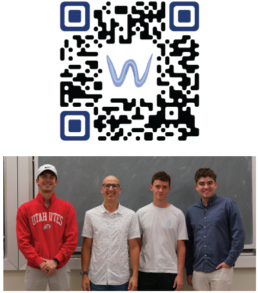
Team: Worm World
Genetics researchers seek to determine how genes, the basic units of biological inheritance, influence the observable characteristics of organisms. The work done by geneticists includes cross-breeding (“crossing”) different strains of a species to obtain a target genetic profile. The current state-of-practice is to draw these cross trees and calculate offspring probabilities by hand, which can be error prone and time consuming. Our multi-platform desktop application allows researchers of the model organism C. Elegans to design, save, and share strain pedigrees that model the inheritance of relevant genes across generations according to statistical patterns. With this tool, researchers can streamline their experimental planning and data analysis, ultimately improving the efficiency and accuracy of their research.
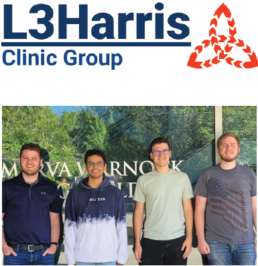
Team: L3 Harris Clinic
All systems in a network are typically controlled via a centralized server. These servers will typically handle all connections and connect each caller to the person they intend to call. However, this approach has limitations in various high-stakes situations where you need to maintain communication without a single point of failure. To combat this, we have developed a distributed call management system that automatically meshes between users, without the need for a centralized server. This was achieved by creating, designing, and implementing a communication protocol for Linux and Windows platforms that uses multicast RTP to allow users to create and join calls on a network without requiring input from any centralized source.
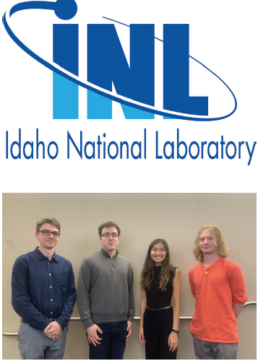
Team: INL Clinic
Idaho National Laboratory (INL) has developed the All Hazards Analysis (AHA) framework in order to record information about the nation’s critical infrastructure and simulate the consequences of a disruption. The Spatial Enrichment Data Engine (SEDE) is a new and independent web service which will validate and assign accurate geospatial data to the infrastructure in INL’s AHA framework. We will provide non-spatial (e.g., address, zip code) and spatial information (latitude/longitude) by developing a forward and reverse geocoding application. We will also supply elevation data to INL to support flood simulations. Finally, we’ve developed a user interface to validate functionality and display geocoded results on a map.
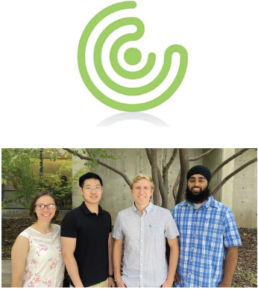
Team: CaptionCall
Secret Keepers is a mobile journal application developed for both iOS and Android devices with the capabilities of capturing audio. Secret Keepers uses React Native for mobile app development, Google’s application programming interface (API) for emotion tracking, audio to text transcription, and data storage. There are two main purposes for Secret Keepers. The first purpose is to gather natural one-sided conversations from a multitude of different ages and ethnic groups. The information gathered will assist CaptionCall, a company who provides technology to people who are hard of hearing, with their speech-to-text predictive model. The second purpose is to be a fun and easy application that encourages people to speak to their devices.
Clinical Capstone Coordinator
Ellen Lewis
Public Relations Specialist
Kahlert School of Computing
University of Utah
ellen.marie.lewis@utah.edu
Faculty Lead for Clinical Capstone Program
Adjunct Professor David Bean
David.bean@cs.utah.edu



